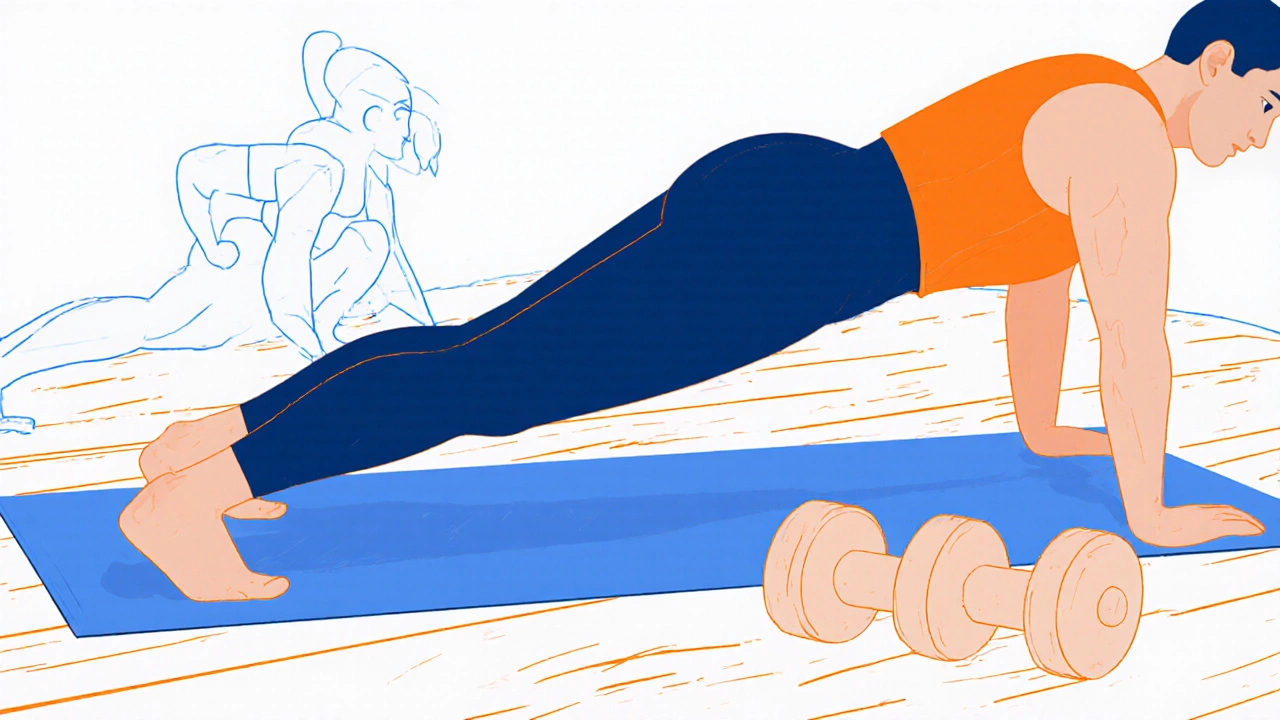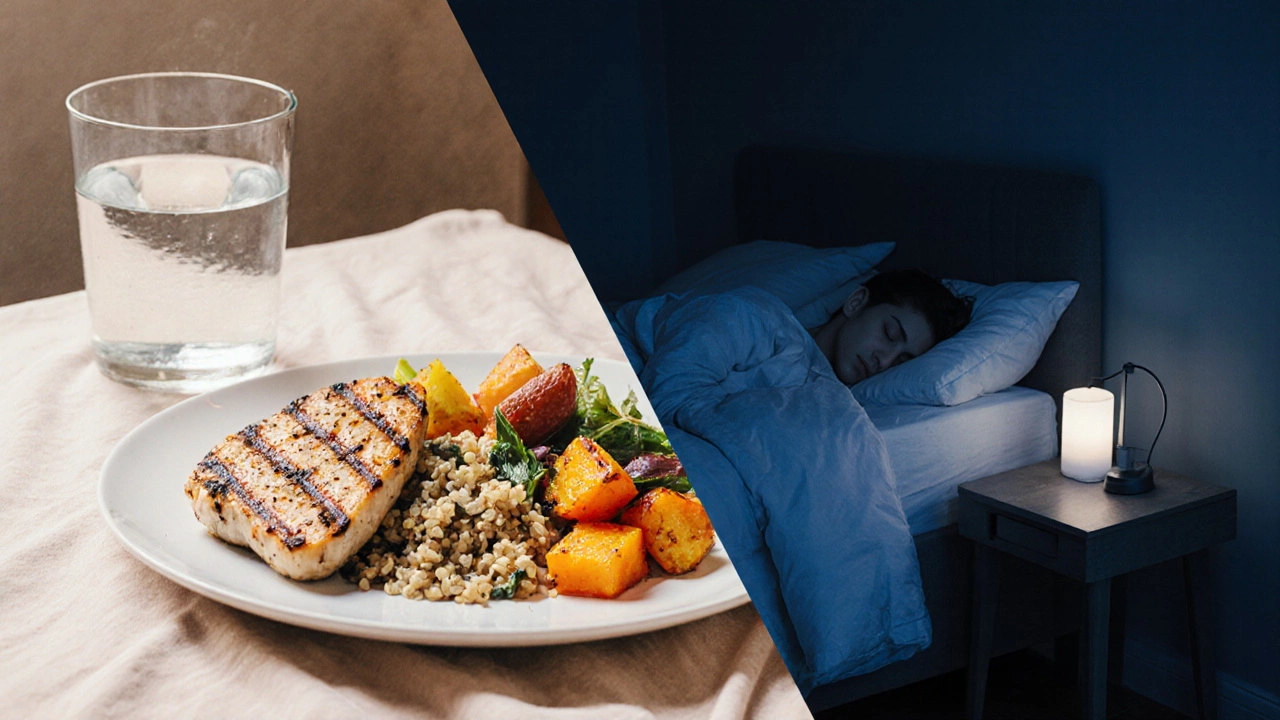
Fat Loss Calorie & Macronutrient Calculator
This calculator uses science-backed principles from the 2‑Week Fat‑Loss Plan. For safe fat loss, we recommend:
- 500 kcal daily deficit (≈0.5 lb/week)
- Protein intake: 1.2-1.5g per kg body weight
- Moderate calorie deficit without muscle loss
Key Takeaways
- Combine high‑intensity interval training (HIIT) with strength work to torch calories in under 30 minutes.
- Maintain a moderate calorie deficit (≈500kcal/day) while keeping protein above 1.2g per kg body weight.
- Prioritize sleep, hydration, and daily movement to keep metabolism humming.
- Follow a three‑phase schedule: burn, build, and fine‑tune.
- Track progress with simple metrics - waist measurement, energy levels, and workout consistency.
Want to see real fat loss in just two weeks? It’s not magic, it’s a blend of science‑backed workouts, smart eating, and lifestyle tweaks. Below is a step‑by‑step plan you can start today, no gym required.
Fat loss is the process of reducing stored body fat through a combination of increased energy expenditure and controlled nutrient intake. The goal isn’t just a smaller number on the scale; it’s preserving muscle, improving insulin sensitivity, and feeling more energetic.
Why Two Weeks Works (and Why It’s Not a Long‑Term Fix)
Two weeks is long enough to see measurable changes in water weight, glycogen stores, and even a few millimeters off the waist. However, sustainable fat loss requires a habit shift beyond the 14‑day sprint. Think of this plan as a jump‑start that builds momentum for the weeks that follow.
Phase1: Burn - Days1‑5
Kick‑off with high‑intensity sessions that spike your metabolism. The core of the burn phase is HIIT - short bursts of all‑out effort followed by brief recovery.
- Warm‑up: 3‑minute brisk walk or jog.
- 20‑second sprint (or jump squats, burpees, mountain climbers).
- 40‑second active rest (slow jog or marching in place).
- Repeat 8‑10 times.
- Cool‑down: 2‑minute stretch.
Do this routine three times a week (e.g., Monday, Wednesday, Friday). On off days, add a 20‑minute brisk walk or light bike ride to keep the calorie burn steady.
Phase2: Build - Days6‑10
Now you’ll protect muscle while continuing to torch calories. Strength training is your ally here. Use body‑weight moves or dumbbells if you have them.
- Day6 & 9 - Upper Body: push‑ups, dumbbell rows, shoulder taps, plank‑to‑push‑up. 3 sets of 12‑15 reps.
- Day7 & 10 - Lower Body: split squats, glute bridges, calf raises, wall sit. 3 sets of 15‑20 reps.
- Day8 - Core + Cardio: bicycle crunches, Russian twists, 10‑minute moderate‑pace jog.
Keep rest periods short (30‑45seconds) to maintain heart‑rate elevation.
Phase3: Fine‑Tune - Days11‑14
This final stretch blends the best of both worlds. Alternate between a HIIT circuit and a strength circuit every other day. Add a mobility routine (foam rolling, dynamic stretches) to improve recovery.
Sample Day11 (HIIT + Core):
- 30‑second high‑knee runs
- 30‑second plank
- 30‑second jump lunges
- 30‑second side plank (each side)
- Repeat 6 rounds.
- 3×10 goblet squats
- 3×12 renegade rows
- 3×15 kettlebell swings (or fast‑pace dead‑lifts)
- Finish with 5‑minute steady‑state jog.

Nutrition Blueprint: The Calorie Deficit That Still Feeds Muscles
The easiest way to lose fat is to eat fewer calories than you burn. Aim for a modest deficit of ~500kcal per day - enough to drop ~0.5lb (≈0.2kg) each week without sacrificing energy.
Here’s how to structure meals:
- Protein intake: 1.2‑1.5g per kg body weight (chicken breast, tofu, Greek yogurt, lentils).
- Complex carbs (sweet potatoes, oats, quinoa) to fuel workouts - keep portions around 1cup cooked.
- Healthy fats (avocado, nuts, olive oil) - limit to 20‑30g total.
- Veggies for fiber and micronutrients - fill half your plate.
Stay hydrated: at least 2L of water daily. Dehydration can masquerade as hunger and slow metabolism.
Sleep & Recovery: The Hidden Fat‑Loss Engine
Less than 7hours of sleep spikes cortisol, which encourages fat storage, especially around the belly. Prioritize:
- Consistent bedtime (same hour each night).
- Dark, cool bedroom (≤18°C).
- Avoid screens 30minutes before sleep.
Even a short nap (20‑30minutes) can improve insulin sensitivity on heavy training days.
Tracking Progress Without Obsession
Scale weight can fluctuate due to water shifts. Use these simple metrics instead:
- Waist circumference - measure at the narrowest point.
- How your clothes fit (especially around hips and thighs).
- Energy levels during workouts.
- Consistency - aim for 90% adherence to the schedule.
Comparison of Popular Short‑Term Fat‑Loss Methods
| Method | Avg. Calories Burned (30min) | Equipment Needed | Difficulty |
|---|---|---|---|
| HIIT | 350‑450kcal | None or light dumbbells | High |
| Circuit Training | 300‑380kcal | Basic dumbbells or body weight | Medium‑High |
| Steady‑State Cardio | 250‑300kcal | Treadmill, bike, or outdoor space | Medium |

Common Pitfalls & How to Dodge Them
- Over‑cutting calories. Dropping more than 1,000kcal/day leads to muscle loss and burnout.
- Skipping strength work. Cardio alone can burn calories but also erodes lean mass.
- Ignoring recovery. Persistent soreness means you’re not repairing muscle, which stalls fat loss.
- Relying on the scale. Use waist measurements and how you feel as primary indicators.
What to Expect After the Two Weeks
Most people see 1‑3lb (≈0.5‑1.4kg) of weight loss, a tighter waist, and a noticeable boost in stamina. The real win is the habit loop you’ve created - a blend of quick‑fire workouts, balanced meals, and recovery practices you can keep extending.
Next Steps for Long‑Term Success
- Gradually shift from a 500kcal deficit to maintenance once you’ve reached your initial goal.
- Rotate workout styles every 4‑6 weeks to avoid plateaus (e.g., swap HIIT for a mixed martial arts circuit).
- Continue tracking waist size and energy levels rather than obsessing over daily fluctuations.
- Consider a professional assessment (nutritionist or trainer) if you hit a stall.
Frequently Asked Questions
Can I lose belly fat in just two weeks?
Spot‑reduction isn’t possible, but a calorie deficit combined with HIIT and core‑strength work will shrink overall body fat, including the belly area, noticeably within 14days.
Do I need a gym membership for this plan?
No. All exercises can be done with body weight or a pair of light dumbbells. A sturdy chair and a mat are enough.
How many calories should I eat each day?
Calculate your maintenance calories (usually 14‑16kcal per lb of body weight) and subtract 500kcal. Most adults land between 1,500‑2,200kcal/day.
Is it safe to do HIIT every day?
High‑intensity sessions should be limited to 3‑4times a week. Your muscles need 48‑72hours to recover fully.
What if I’m vegetarian or vegan?
Swap animal protein for legumes, tempeh, seitan, or plant‑based protein powders while keeping the same gram targets.
